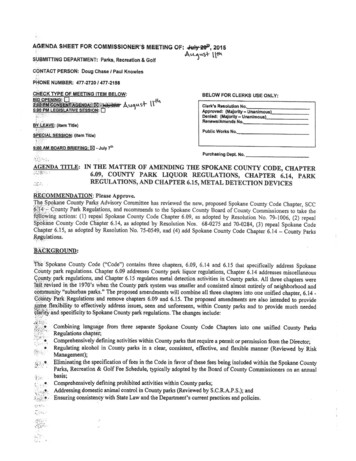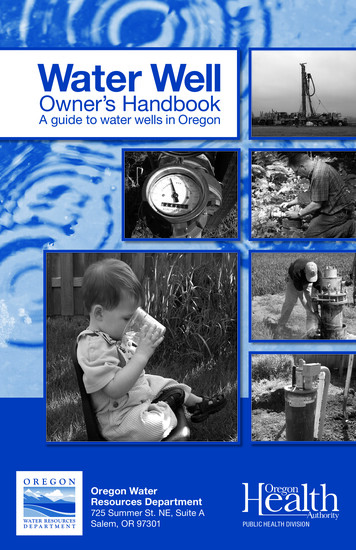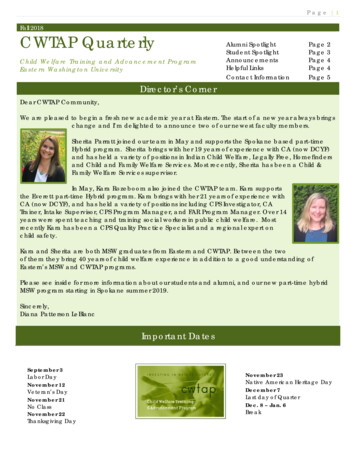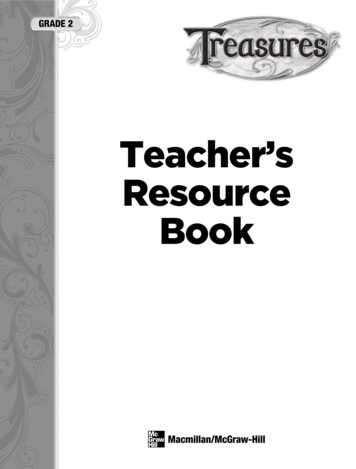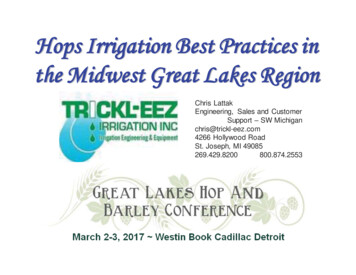
Transcription
Hops Irrigation Best Practices inthe Midwest Great Lakes RegionChris LattakEngineering, Sales and CustomerSupport – SW Michiganchris@trickl-eez.com4266 Hollywood RoadSt. Joseph, MI 49085269.429.8200800.874.2553
Chris LattakMSU 1999, JD 2002,but continuously learningTrickl-eez IrrigationSystem design, sales, installationNye Heritage Farms & Apple Barn,LLC - Co-owner, Farm Manager 11 years, working primarilywith new, smaller growers K-Line Pasture Irrigation Vinifera, Hops, Pome, Stone,Berries, some veggies Frost Protection Sub-surface Drip in field crops Focus on innovations in theindustry - where is the industryoing?going? 110 acre fruit and vegetablefarm in SW MI Nye's Apple Barn & FarmMarket, St. Joseph, MI Returned to the farm in 2004after unexpected passing ofstep-dad Juice grapes, apples, peaches,sweet cherries, pears, berriesall manner of veggies, squashand pumpkins for the marketTrickl-eez Irrigation - Chris Lattak(chris@trickl-eez.com)
Why Irrigate? Ability to apply water when, where,and in the amounts necessary tosatisfy the needs of the hop plantAbility to most economically andefficiently apply nutrients; spoon feedMore uniform, successful and rapidplant establishment and growthSignificant yield increases of greaterthan 20% vs. unirrigated. (20% isconsidered a low number)Increase of Alpha acids vs. unirrigated Growth @ 12 months from plantingTrickl-eez Irrigation - Chris Lattak(chris@trickl-eez.com)
Irrigation Options * Italics are points that I have addedDripper lines suspended 14”- 18” above rows offer theadvantages of easy inspection/maintenance; stay in place yeararound; give a coir twine fastening point; and avoid damage frommechanical cultivation. Possible con: cannot cross cultivate hopyard (or cross rows to hang coir twine).On the ground drip lines can be rolled up each season; allowclump-style growing & cross cultivation. Possible cons: harder toinspect, no tie spot for coir twine; prone to more mechanical damagefrom cultivation; shorter life span; greater animal or insect damage.Buried drip tape – not recommended. Cannot inspect, often damaged duringrhizome removal, not designed to match the longevity of a hop yard, potential forroots to pinch off water delivery.Overhead sprinklers. Overhead irrigation, or center pivot can be used successfullyby growers who understand wet leaf diseases and time irrigation cycles to minimizewet leaf periods. Possible cons: has to be elevated to pole height; somewhat unevendistribution of water; (very inefficient – 40% can be lost to wind and evaporation);cannot be used effectively in windy weather, and is difficult to create differentwatering zones. Overhead sprinklers are best used in conjunction with drip irrigationto cool leaf temps on varieties susceptible to heat stress.Trickl-eez Irrigation - Chris Lattak(chris@trickl-eez.com)From Great LakesHops website withitalics added
Suspended or On GroundSuspendedOn GroundFlatwater FarmsTrickl-eez Irrigation - Chris Lattak(chris@trickl-eez.com)
Suspended or On Ground Irrigation linesHanging Coir; Cross cultivatingTrickl-eez Irrigation - Chris Lattak(chris@trickl-eez.com)
If replacing drip line with any regularityHeavy Wall Emitter Line (45mil)vs Thin Wall Emitter Line (20mil)Assuming 14’ row spacing - 3,100lf/acre; catalog pricing Heavy Wall Emitter Line (45mil)Normal 20 year life span(above ground)Installed on the ground, movedmultiple times (2-3?) per seasonfor cultivation & removed forcross cultivation, and reinstalled annuallyReplaced every 4 years 148/1,000’ x 3,100’ 459/a Thin Wall Emitter Line (35mil)Normal 10 year life span(above ground)Installed on the ground, movedmultiple times (2-3?) per seasonfor cultivation & removed forcross cultivation, and reinstalled annuallyReplaced every 4 years 100/1,000’ x 3,100’ 310/aTrickl-eez Irrigation - Chris Lattak(chris@trickl-eez.com)
Are we applying too much water?Trickl-eez Irrigation - Chris Lattak(chris@trickl-eez.com)
Water and the Soil Soil TypesWater movement in the soil?Water holding capacity of the soil?How much water do we need?Trickl-eez Irrigation - Chris Lattak(chris@trickl-eez.com)
Soil Types, and Infiltrationbased on TextureTrickl-eez Irrigation - Chris Lattak(chris@trickl-eez.com)
Trickl-eez Irrigation - Chris Lattak(chris@trickl-eez.com)
Capillary Action Capillary action (sometimes capillarity,capillary motion, or wicking) is the abilityof a liquid to flow in narrow spaces withoutthe assistance of, or even in opposition to,external forces like gravity.Trickl-eez Irrigation - Chris Lattak(chris@trickl-eez.com)
How does water move in the soil?Trickl-eez Irrigation - Chris Lattak(chris@trickl-eez.com)
Movement of water in the soilTrickl-eez Irrigation - Chris Lattak(chris@trickl-eez.com)
Water movement across different soiltypes; Affect of compaction on soilTrickl-eez Irrigation - Chris Lattak(chris@trickl-eez.com)
Water Holding Capacity****Saturation – all soil pores completely filledField Capacity – Saturated, allowed to drain 24-48 hoursPermanent Wilting Point – Point at which plant has extracted all thewater that it canWater Holding Capacity Field Capacity – Permanent Wilting PointPlant Available Water – 50% of Water Holding Capacity*Trickl-eez Irrigation - Chris Lattak(chris@trickl-eez.com)
USDA Soil Web SurveyTrickl-eez Irrigation - Chris Lattak(chris@trickl-eez.com)
USDA Map Unit Description*Trickl-eez Irrigation - Chris Lattak(chris@trickl-eez.com)
Determining Plant Available Water**Trickl-eez Irrigation - Chris Lattak(chris@trickl-eez.com)
Target area A hop plant’s tap root canextend down 15’ The majority of a hop plant’sroots are in the top 6” to 8” –where soil biologicals, nutrientsand oxygen are located, but theroots will extend down 4’ andout well into the drive middle(remember Mycorrhizae/rootsymbiosis) Irrigation tubing with emittersevery 24” will have a solidwetted area the length of therow and up to 3’ wide onmedium to light soils (possiblymore on heavier soil) Irrigation depth (and width)depends on soil type and thelength of the irrigation setTrickl-eez Irrigation - Chris Lattak(chris@trickl-eez.com)
Roots &MychorrhizaeRoots only"Mycorrhizal fungi increase the surface absorbing area of roots 100 to a 1,000 times,thereby greatly improving the ability of the plant to access soil resources. Several miles offungal filaments can be present in less than a thimbleful of soil. Mycorrhizal fungi increaseRootsonlynutrientuptakenot only by increasing the surface absorbing area of the roots, but alsorelease powerful enzymes into the soil that dissolve hard-to-capture nutrients, such asorganic nitrogen, phosphorus, iron and other “tightly bound” soil nutrients. Thisextraction process is particularly important in plant nutrition and explains why nonmycorrhizal plants require high levels of fertility to maintain their health. Mycorrhizalfungi form an intricate web that captures and assimilates nutrients, conserving thenutrient capital in soils." - Mycorrhizal Applications, Inc.Trickl-eez Irrigation - Chris Lattak(chris@trickl-eez.com)
MycorrhizaeTrickl-eez Irrigation - Chris Lattak(chris@trickl-eez.com)
Water Holding Capacity*Soil Biology can access water and nutrient reserves not available to a plant's roots and root hairsPlant root and root hairs can, generally, access 25-30% of the moisture content of the soil, asmeasured at full field capacityb. The remaining 70-75% is so tightly held/adsorbed by soil colloids and aggregates that theyare not plant availablec. Mycorrhizal Fungi and Bacteria are capable of accessing an additional 40% of thewater held in the soili. Mycorrhizae increase the surface absorbing area of plant's roots by 100 – 1,000 timesii. Mycorrhizae release enzymes that dissolve hard to capture nutrients that are tightlybound in the soil (ie. N, P, Fe) for their own life processes, but will also transfer themdirectly to the plant's rootsTrickl-eez Irrigation - Chris Lattak(chris@trickl-eez.com)
Why are we applying water?Evapotranspiration (ET)Loss of water from soil evaporation and by transpiration from the plants growing thereonCrop Coefficients* **Trickl-eez Irrigation - Chris Lattak(chris@trickl-eez.com)
Water Use by Hops30” during the Season - When? How Much?!?!“A goal without a plan is just a wish.” Goal 30” in a 5 month period90% during heavy growth periodbetween training and flowering(Mid May to Late July)Deficit irrigation will stunt growthand result in fewer and smallerflowersFrom April through August 2013,the base Evapotranspiration (ET)Rate in Southwest MI was22.58”. Take into account a 1.2?(not 1.0) coefficient for hops andthat is about 27” for the 2013season.Trickl-eez Irrigation - Chris Lattak(chris@trickl-eez.com)
How much water using drip?We still need to take into account significant rain events (generally .25”) In the height of summer, a hop plantcan require 16gal/plant/week.With 3.5’ plant spacing and 14’ b/nrows, 16ga/plant/week using RAMw/ 24” emitter spacing at .42gph 1.85”/week (run time of 21.8 hrs/wk)for a 4’ wide area running the entirelength of the row.However, giving drip a 95%efficiency rating, we are actuallyonly applying just over .08”/hr, SO.21.8hrs/wk is actually applying app.1.75 inches/week.To achieve 1.85”, taking intoaccount the 95% efficiency, divideour run time of 21.8hrs by .95. Giving us a target ofirrigating 23 hrs/wk at theheight of summer (2”/week).Trickl-eez Irrigation - Chris Lattak(chris@trickl-eez.com)
Irrigation tips Match emitter application rate and spacing to the soiltype/organic matter (also remember that 1% OM 1acre inch of water holding capacity) Irrigate early in the day to keep water cool Alternate days to allow time for soil to dry down Pulse irrigate in lighter soils; keep the soil moist, notwet; and do not flush oxygen out of the root profileby over watering Occasional deep irrigation (not after fertigation) tosend roots deep and flush salts Boots on the ground – numbers from ET, moisturesensors, etc. will never fully replace what you seeand touchTrickl-eez Irrigation - Chris Lattak(chris@trickl-eez.com)
Moisture sensors in trickle irrigated vegetables Sample representative soils – 2 or more locations Probe should be approximately 12” from an emissionpoint Best to measure at least two depths– First probe at 6-8”– Second probe at 18”– More depending on crop root structure Monitor the probes often Error on the side of over irrigating rather than underirrigatingTrickl-eez Irrigation - Chris Lattak(chris@trickl-eez.com)
Moisture Monitoring / Moisture SensorsShould we be using ET, water/moisture content,soil tension, something else? We are continuously trialing products, all with benefits anddetrimentsSimple, reasonably priced systems track information / providemeasurements– Temp., humidity, ET, rainfall, wind, moisture sensors– Information for you to interpret and a basis to make decisionsComplex systems – everything and the kitchen sink, when all youreally need is the sink and maybe a toaster oven– You still have to interpret– System can control irrigation - pumps, zones, duration, etc– Mixed results Soil Tension based systems?What issues are we seeing with current systems?Trickl-eez Irrigation - Chris Lattak(chris@trickl-eez.com)
Typical Irrigation Scheduling(year following establishment) 3 to 4 days per week (every other day) 1 to 2 (maybe even 3 in light soils, or early in theestablishment year) times per day depending on soils at the height of the season, as much as 3 1/2 hrs per day,everyday (or 7 hours every other day) An occasional deep soak (send the roots deep), but notimmediately following a nutrient application In the year of establishment, shorter irrigation sets, butmore often, are more appropriate for the existing, smallerroot structure. However, we do want to encourage theroots to delve deeper as the plant matures.Trickl-eez Irrigation - Chris Lattak(chris@trickl-eez.com)
What is water’s function within a plant?In a plant’s environment? maintaining cell turgidity for structureand growth;transporting nutrients and organiccompounds throughout the plant;carrying the dissolved sugar and othernutrients throughout the plant, as wellas to the roots and soil;comprising much of the livingprotoplasm in the cells;serving as a raw material for variouschemical processes, includingphotosynthesis;and, through transpiration, bufferingthe plant against wide temperaturefluctuations.Trickl-eez Irrigation - Chris Lattak(chris@trickl-eez.com)
Trickl-eez Irrigation - Chris Lattak(chris@trickl-eez.com)
Trickl-eez Irrigation - Chris Lattak(chris@trickl-eez.com)
Trickl-eez Irrigation - Chris Lattak(chris@trickl-eez.com)
Trickl-eez Irrigation - Chris Lattak(chris@trickl-eez.com)
Trickl-eez Irrigation - Chris Lattak(chris@trickl-eez.com)
Trickl-eez Irrigation - Chris Lattak(chris@trickl-eez.com)
Trickl-eez Irrigation - Chris Lattak(chris@trickl-eez.com)
Soil/Plant/Biological/Water/Nutrition Interaction –What are the primary takeaways?1) Soil (Nutrients and Biology) work integrally with plantsa. Soil is the plant's digestive systemb. Plants feed the soil biology; in an extremely healthy relationshipi. 70% of a plant's photosynthates (simple sugars/energy) are sent throughthe roots out to the soil biologyii. If you had 100# of plant above ground, 100# below, then 460# of growthis sent into the biosystem as exudates2) 2 Models of Plant Nutritiona. Accepted Standard – Plants absorb nutrition directly as simple ions fromthe soil solution. THIS IS ENTIRELY DEPENDENT ON SUFFICIENT MOISTUREi. "Glorified Hydroponics" - soil as hydroponic mediumii. Plants dependent on applied nutrients, water, and only plant rootsiii. Soil biologicals and interactions are minimalb. Real World – nature's way – Plants absorb nutrients as microbialmetabolites produced by the total soil microbial system (soil food web)i. The soil food web – Bacteria, Fungi, Nematodes, Actinomycetes,Protozoa feed on root acids % exudates (sugars, amino acids, lipids)and minerals, nutrition and organic residues in the soil profileTrickl-eez Irrigation - Chris Lattak(chris@trickl-eez.com)
Soil/Plant/Biological/Water/Nutrition Interaction3) Microbial populations need nutrientsa. Microbials digest sugars, absorb nutrients from the soil matrix to buildand reproduce, recycle through the soil food web again and again,eventually turning into stable humic substancesb. Nematodes eat bacteria and produce waste that is released as plantavailable nutrients (amino acids, essential fatty acids, organic acids),and metabolites combined with minerals/nutrients4) Soil Biology can access water and nutrient reserves not available to plant'sroots and root hairsa. Plant root and root hairs can, generally, access 25-30% of the moistureContent of the soil, as measured at full water holding capacityb. The remaining 70-75% is so tightly held/adsorbed by soil colloids andAggregates that they are not plant availablec. Mycorrhizal Fungi and Bacteria are capable of accessing an additional40% of the water held in the soili. Mycorrhizae increase the surface absorbing area of plant's rootsBy 100 – 1,000 timesii. Mycorrhizae release enzymes that dissolve hard to capture nutrientsthat are tightly bound in the soil (ie. N, P, Fe) for their own lifeprocesses, but will also transfer them directly to the plant's rootsTrickl-eez Irrigation - Chris Lattak(chris@trickl-eez.com)
The soil food web is the plant’s digestive systemTrickl-eez Irrigation - Chris Lattak(chris@trickl-eez.com)
Trickl-eez Irrigation - Chris Lattak(chris@trickl-eez.com)
What else should we do with drip?Apply Nutrients (N, C, micros) Water requirementsseem to shadowNitrogen requirementsWisconsinWashingtonTrickl-eez Irrigation - Chris Lattak(chris@trickl-eez.com)
Injecting Nutrients though our drip Timing– Preferably twice per week,at a minimum.– Often every time we irrigate(timers and proportionalinjectors are irreplaceable)– Allow time for water to“energize the system” (fillall the pipe and tubing withwater), then inject, followedby a period to flush thenutrient out of the systembefore the end of the cycleTrickl-eez Irrigation - Chris Lattak(chris@trickl-eez.com)
Soil, Tissue, Sap Analysis Soil analysis - for monitoring soil fertility levels andproviding baseline information– Only tells us what is plant available in the top 4-6” of thesoil Tissue analysis - can account for the plant-availablenutrient pools present at multiple soil depths, and currentnutritional status of the plant as evidenced by plant’s uptake– deficiency in nutrient uptake will be revealed only 4 or 6weeks after the actual nutrient deficiency was caused Sap analysis – “blood test for plants”, compares sap fromboth young and old tissue, compares them to key indicators,and measures the current amount of bioactive nutrientsavailable in the sap to support metabolic activities and plantgrowth – Crop Health Labs, Bellville, Ohio– Detects deficiencies within just a few days, 3-4 weeksbefore a tissue sample would show them, allowingproactive application prior to symptoms, or yield lossTrickl-eez Irrigation - Chris Lattak(chris@trickl-eez.com)
But what aboutWater Quality?And its affect on the soil,soil pH, hydration,nutrient application,spray material . . .Trickl-eez Irrigation - Chris Lattak(chris@trickl-eez.com)
WaterQuality &Reading aWaterAnalysisEmphasis ttakTrickl-eezIrrigationIrrigation )
Trickl-eez Irrigation - Chris Lattak(chris@trickl-eez.com)
Water Quality and Reading a Water AnalysisPrimary Focus for foliar and irrigation nutrient and chemical application pH –- for foliar pesticide applications, ideal around 5.5 to 5.7- for irrigation, most crops we want no greater than 6.5- Blueberries, less than 6.0. preferably 5.0-5.5 Hardness, Bicarbonates- Poor water quality, especially hard water/water high inbicarbonates, can have a very negative impact oneffectiveness of plant nutrition and pesticides whenapplied as a foliar, or in an irrigation system- Hardness below 85ppm – we’re good enough, stillconsider treatment of spray water with aconditioner- Above 150ppm – up to 50% more product to overcomebinding effect of hard water- Above 200ppm without addressing hardness will result innullification of most nutritionals, and significantnegative effects on chemicals applied foliar, or viadrip.Trickl-eez Irrigation - Chris Lattak(chris@trickl-eez.com)
Trickl-eez Irrigation - Chris Lattak(chris@trickl-eez.com)
In Spray and Irrigation Water, what options do we haveto deal with Hardness, Bicarbonates and Iron?Water Treatment UnitsMagnetic (HDMR) or electrical (in order of )– Maximum H2O, Magnation, Pursanova, Talya, WaterChangerSulfur BurnersReverse Osmosis (RO)Chemical/AcidsLow mineral levels – below 100ppm- Citric Acid, Acetic Acid (vinegar), Phosphoric AcidModerate to Moderate/High levels – to 600ppm?- Sulfuric Acid, Oxcide (ChemFresh), Fulvic AcidOtherAmmonium Sulfate (AMS) - binds Ca and FeChemical Water ConditionersTrickl-eez Irrigation - Chris Lattak(chris@trickl-eez.com)
Hydrodynamic Magnetic Resonance (HDMR)– Omni-Enviro Maximum H2O, Pursanova, Talya (electric unit)pH – moderate balancing effectHardness - prevents/removes Ca, Mg and Fe depositsImproves hydration, chemical/nutrient uptakeCost – Moderate/High Initial; No On-goingEffectiveness – Moderate to Moderate/High rigation )
Hard water Before and After passing through theMaximum H2O unit (similar results with other units).Trickl-eez Irrigation - Chris Lattak(chris@trickl-eez.com)
Chemicals / AcidsCitric Acid, Acetic Acid (vinegar) Phosphoric AcidpH – lowers pHHardness – treats up to 100pm (or so)Helps prevent chemical/nutrient tie-upCost – Moderate Initial (Injector), Moderate To Moderate/HighOn-goingEffectiveness – Moderate to Moderate/High up to 100ppmSulfur Burner**, Sulfuric Acid*, Oxcide (Hypochlorous Acid),Fulvic Acid***pH – lowers pH (not Oxcide)Hardness – treats up to 600 ppm ?Helps prevent chemical/nutrient tie-upCost – Moderate (Injector); Moderate/High On-goingEffectiveness – Very* Sulfuric Acid Breaks Down to Sulfate which is detrimental to soil biological health.** Sulfur burners produce Sulfurous Acid and is beneficial to soil biological tion--Chris*** Fulvic AcidTrickl-eezhasextremelypositiveeffectson soil health(chris@trickl-eez.com)(chris@trickl-eez.com)
Trickl-eez Irrigation - Chris Lattak(chris@trickl-eez.com)
Other options that will help with hardness in spraywater to some degreeAMS Equation March 8, 2013 www.btny.purdue.edu/weedscienceThe following is an example water quality report and calculationof how much AMS needs to be added to the spray mixture usingthis equation.The analysis results for the five elements from this report are:Sodium (Na ): 15.7 mg/LPotassium (K ): 1.03 mg/LCalcium (Ca2 ): 68.4 mg/LMagnesium (Mg2 ): 25.21 mg/LIron (Fe2 ): 0.37 mg/L* The values in this example are reported in mg/L, but these valuescould also reported in ppm and the two would be identical innumerical value.The equation with input values would be:AMS (lbs/100gal) 0.005*(Na ) 0.002*(K ) 0.009*(Ca2 ) 0.014*(Mg2 ) 0.042*(Fe2 )Remember from 6th grade math to do the multiplication first, somultiply all values:AMS (lbs/100gal) 0.005*(15.7) 0.002*(1.03) 0.009*(68.4) 0.014*(25.21) 0.042*(0.37)Now do the addition and add all values to get the final answer:AMS (lbs/100gal) 0.0785 0.00206 0.6156 0.35294 0.01554So the final answer is:AMS (lbs/100gal) 1.06464From Spray Adjuvants forFruit Crops – MI FruitManagement Guide 2015 Buffer Xtra Strength –Helena Choice Weather Master –Loveland Weather Gard Complete –LovelandFrom personal experience RidgeRunner – Reister Indicate 5 - ReisterTrickl-eez Irrigation - Chris Lattak(chris@trickl-eez.com)
Reverse Osmosis (RO)pH – balances to neutral - 7Hardness – Vastly decreasesVastly decreaseschemical/nutrient tie-upCost – High Initial; Low/ModerateOn-goingEffectiveness – Extremely* Low volumes – max 7-12gpmGreater volume is extremely expensiveReductions of 50% and greater innutrient and pesticide usage, plusimproved crop performance.Trickl-eez Irrigation - Chris Lattak(chris@trickl-eez.com)
Example of a small systemInjection StationTrickl-eez Irrigation - Chris Lattak(chris@trickl-eez.com)
Electrostatic SprayingElectrostaticSprayingTrickl-eez Irrigation - Chris Lattak(chris@trickl-eez.com)
Electrostatic sprayer benefits 15-40gpa w/superior coverage– ½ the tank fill time45hp max– 2-3gph less diesel, smallertractorSpray pollen Eliminate run-offMinimal driftSave on spray material– Decrease application ratesTrickl-eez Irrigation - Chris Lattak(chris@trickl-eez.com)
Variable Speed Control for theMain Irrigation Pump(Variable Frequency Drive – VFD))ADVANTAGES1)1)2)3)4)5)Soft start to system: Water hammer mostlypreventedLess electricity used, so operating costs are lowerCan convert single phase power to 3-phase current to operatelarger pumps (and lower operating costs)The mainline of the irrigation system stays pressurized. Individualzones or sprayer fill locations can be manually operated withoutretuning to the pump controlsRebates are sometimes available from the power companyWider range of operating volumes, ie 250gpm maximum, then40gpm minimumTrickl-eez Irrigation - Chris Lattak(chris@trickl-eez.com)
Variable Speed Control for the MainIrrigation Pump(Variable Frequency Drive – VFD)DISADVANTAGES1)2)Initial Cost – several thousands of extraIf a mainline break should occur and go undetected,the pump would come on and waste irrigation water,create a muddy mess until the break is discovered andrepairedTrickl-eez Irrigation - Chris Lattak(chris@trickl-eez.com)
Methods of Fertilizer Injection1) Venturi Injectorsa)b)c)d)Low costNo electricity neededSet up on a bypass systemCreates 8-15psi of main line pressure loss whileoperating2) Water Driven Injector Pumpsa)b)c)d)e)Moderate CostNo electricity neededProportionalNon-proportionalCan be portable with quickconnectsTrickl-eez Irrigation - Chris Lattak(chris@trickl-eez.com)
Methods of Fertilizer Injection3) Electric Injector Pumpa)b)c)d)No loss of main line pressureEasily adjustableDependable for automatictomatic injectionCan be ordered withth acid head to doboth fertilizer and/oror acide) Electricity requiredTrickl-eez IrrigationIrriigation - Chris m)
Backflow prevention – protectingour water supplies Basic check valve, no airgap – spring or flap Air gap, expensive(especially at theagricultural scale),significant pressure loss,problems with anythingbut “clean” water Chemigation Valve - AirGap, cost effectiveTrickl-eez Irrigation - Chris Lattak(chris@trickl-eez.com)
Pressure Regulators Prevents over pressurizing and damaging thevegetable tape (normal operating pressuredepends on tape wall thickness, but is usually 812psi) Insures optimum water output Must be mounted in-line, usually at the zonevalve Can be added to solenoid valve operationTrickl-eez Irrigation - Chris Lattak(chris@trickl-eez.com)
Air Relief ValvesAre valves are very important components of agood irrigation system and are often overlookeda) Allows trapped air to escape, greatly preventing waterhammer and resulting blow outsb) May be kinetic or continuous actingc) Must be located at high points of the piping systemand at valvesd) Allows air inlet when draining the irrigation systemTrickl-eez Irrigation - Chris Lattak(chris@trickl-eez.com)
What are the best filter options fortrickle irrigation where the watersource is surface water? Sand Filters – provide the best filtration –use #16 sharp silica sand Disc Filter – 120, 140, or 200 mesh Screen Filter– 120 or 150 meshShould the filter backflush (cleaning of filter)be manual or automatic?Trickl-eez Irrigation - Chris Lattak(chris@trickl-eez.com)
Flow Meters Being able to monitor water flow is very valuable– To check pump output & troubleshoot– Abnormal flow rates will indicate trouble– Ability to record (and report if necessary) overallwater usage Several types of flow meters– Pilot tube (basic and instantaneousneous only)– Paddle wheel (digital)– In-lineTrickl-eez Irrigation - Chris Lattak(chris@trickl-eez.com)
Pressure gauges – an inexpensivediagnostic tool1) Air filled, or Liquid filled – Liquid are usually higherquality and longer lasting; helps even out vibrationsfrom being located close to the pump¾ Install a pressure gauge on either side of the filter tomonitor pressure loss through the filter¾ Install on every zone valve on outlet side (inlet sideis also helpful)¾ May have to remove pressure gauges for the winterto keep from freezingTrickl-eez Irrigation - Chris Lattak(chris@trickl-eez.com)
Trickl-eez Irrigation - Chris Lattak (chris@trickl-eez.com) Saturation -all soil pores completely filled Field Capacity-Saturated, allowed to drain 24-48 hours Permanent Wilting Point -Point at which plant has extracted all the water that it can Water Holding Capacity Field Capacity -Permanent Wilting Point Plant Available Water -50% of Water Holding Capacity
